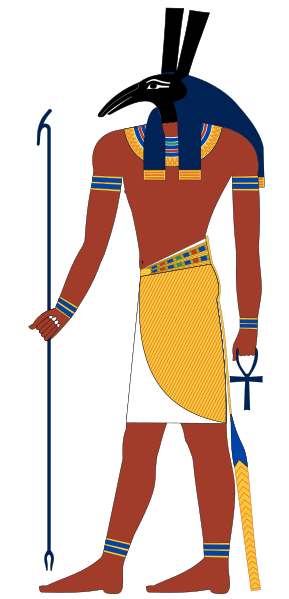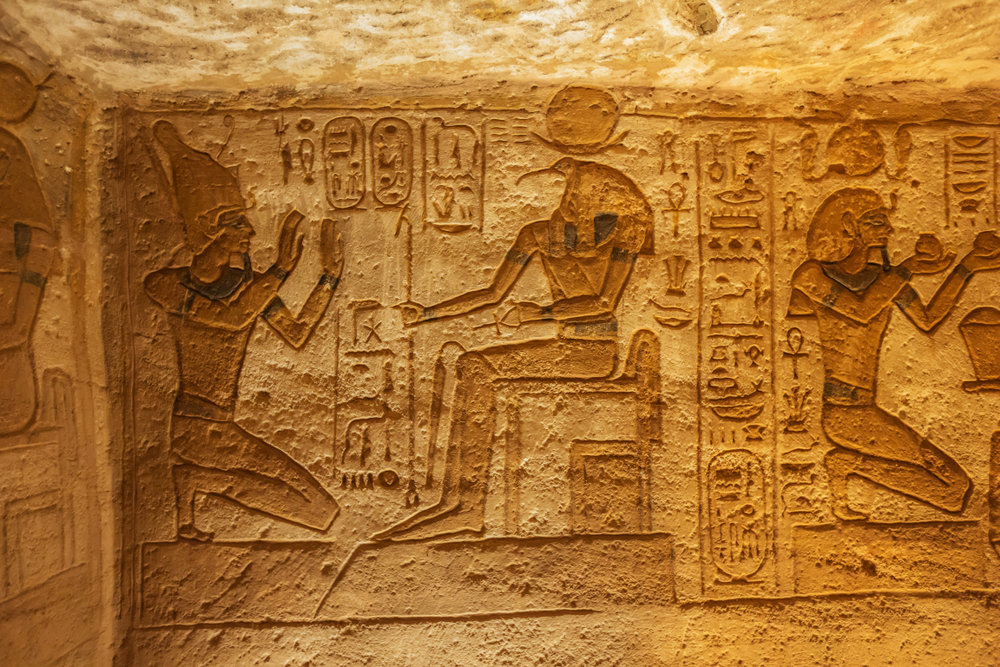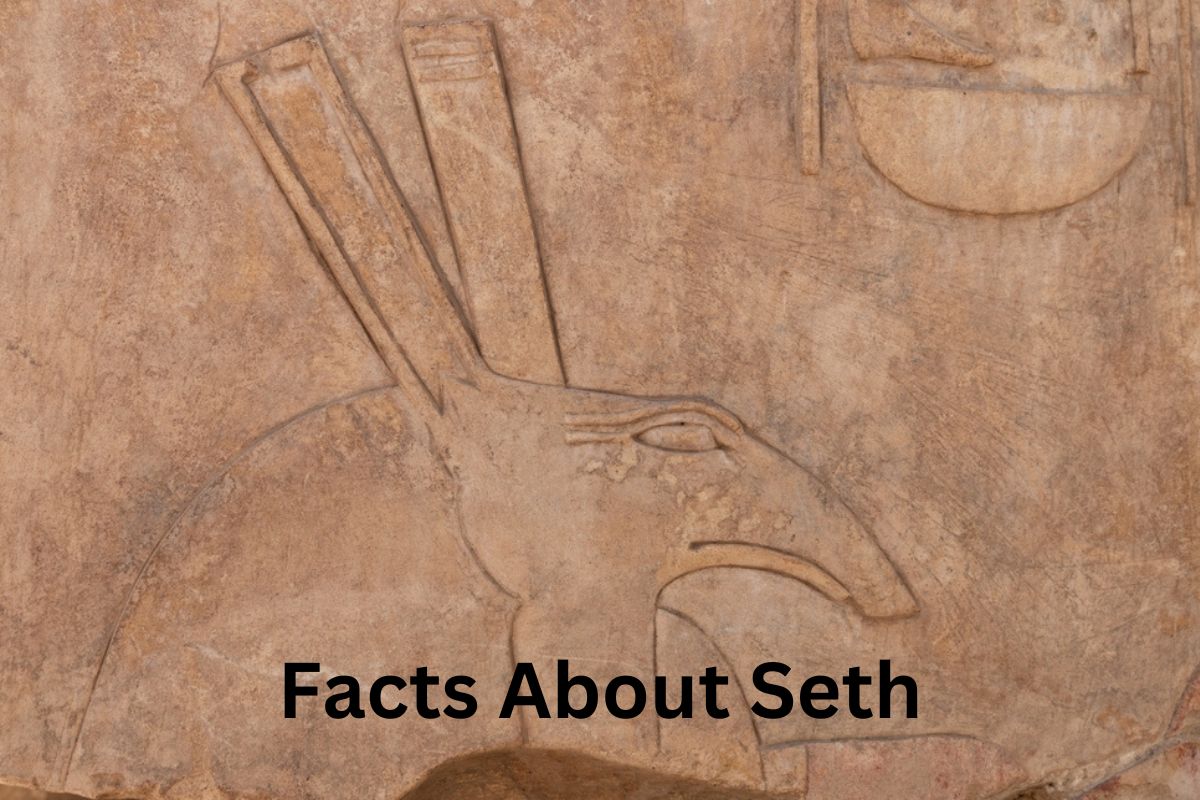Seth, also known as Set, is an ancient Egyptian deity whose name means “to overpower” or “to make a distinction.” He is associated with chaos, violence, storms, and the desert.
Seth played a complex role in Egyptian mythology and was both revered as a protective deity and feared as a symbol of disorder. He was depicted with the head of an unidentified animal, emphasizing his enigmatic nature.
Over time, Seth’s reputation shifted, and he became associated with disruptive forces and the antagonist in the conflict with his brother Osiris and nephew Horus. Despite being portrayed negatively in some accounts, Seth still had pockets of worship and was believed to have the power to protect against evil.
Temples dedicated to Seth were built, including the famous temple in Ombos. However, as the influence of other gods grew, Seth’s worship declined, and his depictions were defaced or destroyed, resulting in a diminished presence in Egyptian religious beliefs.
Seth Egyptian God Facts
1. Seth, also known as Set, is an ancient Egyptian deity associated with chaos, violence, storms, and the desert
Seth, also known as Set, is an ancient Egyptian deity associated with chaos, violence, storms, and the desert. He played a complex role in Egyptian mythology and was one of the most enigmatic and controversial gods in the ancient pantheon.
His name, Set, likely derives from the Egyptian word “s-t,” which means “to overpower” or “to make a distinction.”

2. In Egyptian mythology, Seth was the son of Geb (the earth) and Nut (the sky), and the brother of Osiris, Isis, and Nephthys
In Egyptian mythology, Seth was the son of Geb (the earth) and Nut (the sky), and the brother of Osiris, Isis, and Nephthys. He was often depicted as a human with the head of an unidentified animal, which has been subject to various interpretations.
3. Seth is often depicted as a mysterious and powerful deity with the head of an unidentified animal
Seth is often portrayed as a mysterious and powerful deity with unique characteristics. His iconography typically includes a long, curved snout, erect ears, a forked tail, and an unusually shaped head.
These physical attributes, combined with his animalistic representation, emphasized Seth’s connection to the wild, untamed aspects of nature. The donkey or aardvark-like head has been interpreted as symbolizing Seth’s role as a desert-dwelling god, representing the harsh and unpredictable nature of the arid regions of Egypt.
This association with the desert aligns Seth with barrenness, desolation, and the chaotic forces that existed outside the fertile Nile valley.
4. Seth was initially regarded as a protective and revered deity, associated with the desert and its harsh but essential qualities
Seth was initially regarded as a protective and revered deity associated with the desert and its harsh but essential qualities.
In the early periods of Egyptian history, he was often depicted as a beneficent god, assisting the sun god Ra in his nightly journey through the perilous underworld. Seth was considered a defender against the chaotic forces that threatened the ordered world.

5. One of the most well-known stories involving Seth is the conflict between him and his brother Osiris
Over time, Seth’s reputation underwent a significant shift, and he came to be associated with chaos and disorder. This transformation can be attributed to several factors, including the changing political landscape and the rise of Osiris as a more prominent deity.
Seth’s rivalry with Osiris played a crucial role in shaping his negative image. According to the myth, Seth grew jealous of Osiris’ popularity and murdered him, dismembering his body and scattering the pieces. This act symbolized the disruption of order and the fragmentation of the natural world.
6. Seth was often portrayed as a rival to Horus, the son of Osiris and Isis
One of the most enduring conflicts involving Seth is the battle with his nephew Horus, the son of Osiris and Isis. The conflict between Seth and Horus represented the struggle between chaos and order, and it took various forms depending on the specific mythological accounts.
These conflicts often involved complex schemes, battles, and legal disputes in the divine realm. The outcome of these confrontations was pivotal for the stability and balance of the cosmos, as Horus represented order, kingship, and fertility, while Seth embodied chaos and disruption.
7. Seth was also associated with storms and natural disasters
Seth was also associated with storms and natural disasters. He was believed to control the powerful winds and destructive forces of nature, such as storms, floods, and sandstorms.
As a result, he was both feared and respected for his unpredictable and potentially devastating nature. Seth’s association with these natural phenomena contributed to his portrayal as a deity capable of unleashing havoc and disorder, reflecting the destructive aspects of the natural world that were beyond human control.
8. Despite his negative aspects, Seth was not universally vilified in ancient Egypt
Despite his negative aspects, Seth was not universally vilified in ancient Egypt. In some regions, particularly in the western part of the country, Seth continued to be worshiped and regarded as a powerful deity. In these areas, he was often seen as a protective force against harmful forces and evil spirits.
Some communities believed that Seth’s chaotic nature could be harnessed and directed for beneficial purposes, such as in rituals aimed at warding off malevolent entities or protecting against natural disasters.
9. Temples dedicated to Seth were built in various parts of Egypt
Temples dedicated to Seth were built in various parts of Egypt, with one of the most famous being the temple of Seth in Ombos (now known as Kom Ombo). This temple was situated on the eastern bank of the Nile and was shared with the worship of Horus.
The dual temple was a unique representation of the ongoing rivalry and balancing act between Seth and Horus. The temple complex featured multiple sanctuaries, halls, and courts, reflecting the prominence of Seth’s cult in the region.
10. Over time, Seth’s worship declined, and he became associated with evil and chaos in the eyes of the ruling pharaohs
Over time, Seth’s worship declined, and he became associated with evil and chaos in the eyes of the ruling pharaohs. During the New Kingdom period, pharaohs aligned themselves with the solar deity Amun-Ra and his counterparts, such as Osiris and Horus, as symbols of stability, order, and kingship. This led to a diminishing of Seth’s status and influence.
His depictions on temple walls and monuments were often defaced or destroyed, symbolically eradicating his presence. As a result, Seth gradually became a less prominent figure in Egyptian religious beliefs, with his worship eventually fading away in favor of other deities associated with order and harmony.
